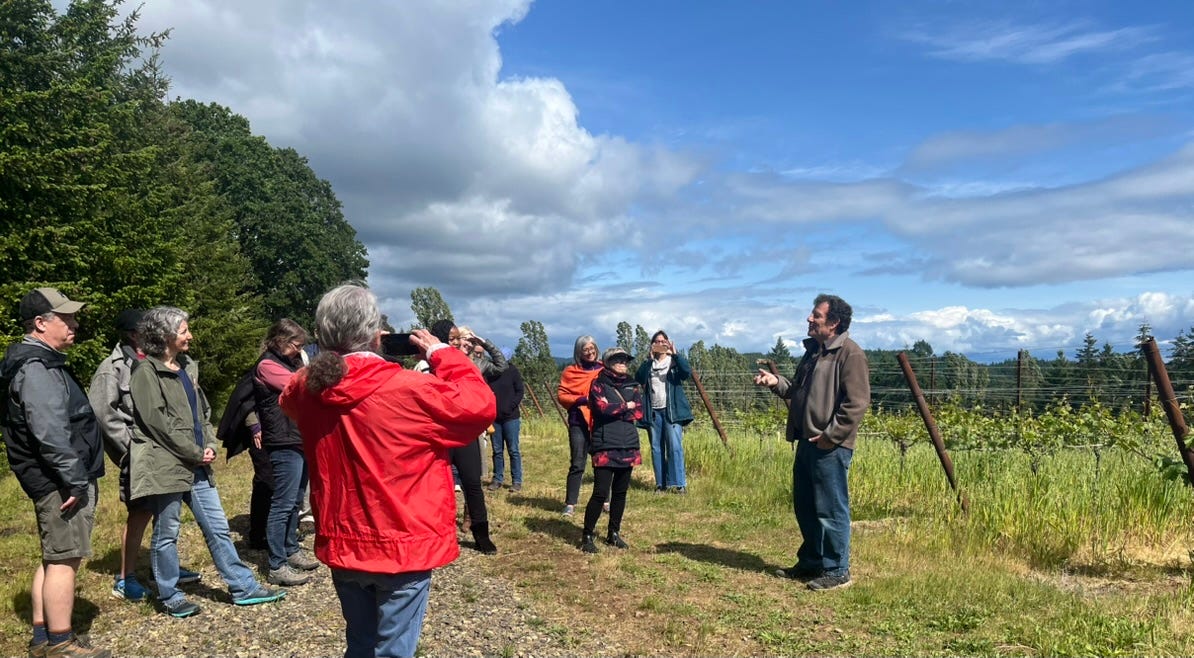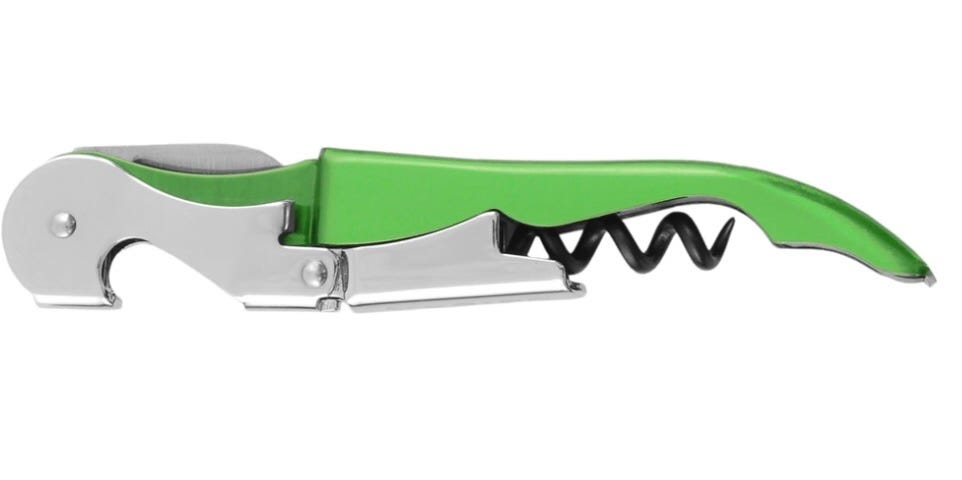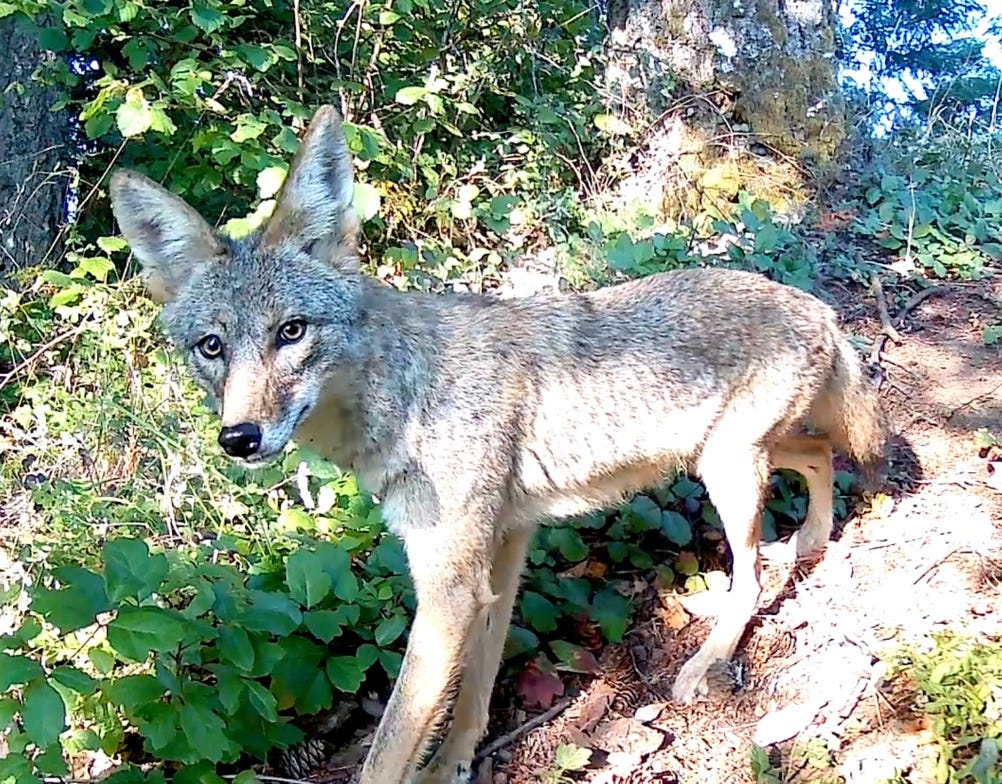No Fancy-Pants Tasting Room Here!
Just our converted sheep shed draped with modern art (and really fine wine!)
Meet a future bottle of Pinot Noir!
As you can see in the video, the grapes are developing very quickly now. They’ll grow larger and change color, turning a beautiful purple, and become juicy and sweet. These are from our Pinot Noir vineyard, from a variety called Pommard, but all our grapes are growing like gangbusters.
Soon we’ll engage in a practice that is traumatizing for a farmer: We’ll thin the grape bunches and leave many on the ground to rot. It’s counter-intuitive to reduce your crop yield, but the upshot is that the remaining grapes will make better wine — and that is what we’re after, the finest Pinot Noir we can make. But you may want to hold our hands as we engage in that fruit-thinning, for it is truly sad to see tons of grapes squandered on the ground (and they’re not yet ripe, so they can’t be donated).
Some vineyards have fancy-pants tasting rooms with chefs who earn Michelin stars. Our tasting room is our old sheep shed, where Nick raised his 4-H and FFA Corriedale sheep. If the barn wall behind Nick and Sheryl in this photo looks a little battered, that’s because when Nick was 13 and driving a tractor for the first time, he drove it through that wall.
Still, the gaps in the boards do speak to authenticity: This is our farm, and it has been in our family for more than half a century. And we’re proud to share it periodically with visitors — as we’ll do again with Pinot and Perspective tastings on July 19 and 20. So if you’re in the area that weekend, we welcome you!
We do tastings in groups of 15 to 20, and we start with asking people to introduce themselves briefly. Then we talk about the farm as we share four to five ciders and wines, speaking about them and also taking questions about…everything. Everything from organic farming to President Trump’s crackdown on immigrant labor to the latest in the Middle East and China.
We conclude with a tour of the vineyard, and this again is mostly a conversation about everything under the sun.
We should also say that even if our tasting room isn’t so elegant, our wine definitely is — as critics keep attesting. Just last month, Wine Spectator praised Willamette Valley Chardonnays as some of the best in the world and then listed eight outstanding examples; ours led the list. And our cider keeps winning awards; most recently we won platinum at the Northwest Cider Association awards a couple of weeks ago.
Our tastings will be at 4:30 p.m. on Saturday, July 19, and 2:45 p.m. and 4:30 p.m. on Sunday, July 20. Each session is $50/person which is applied toward any purchase of six or more bottles or to a new Wine Club or Cider Club membership. Space is limited to 20 guests per tasting, so be sure to book soon, by emailing us at info@kristoffarms.com.
And remember that if those days don’t work for you, or if you simply want to sip on your own, our wines are always available at the tasting room of the Carlton Winemakers Studio nearby; we’re part of the Studio and its lovely tasting room is open 11 a.m. to 5 p.m. every day of the week. You can also try some other great local wines there; ask for recommendations. We also do tastings by appointment for groups of 10 or more; email info@kristoffarms.com for details.
So how do you open a bottle of wine?
That’s a question we’ve been asked more than you’d think. Maybe it has to do with the profusion of cork-removing devices. For example, if you have more money than you know what to do with, check out the $475 Oeno Motion Nomad lever corkscrew. But we think your money would be better spent on a great wine.
The truth is that almost everyone in the wine industry uses the simplest of corkscrews, a simple waiter corkscrew costing less than $10. Here’s the kind that we use, which is also recommended by Wirecutter:
We asked Nick George of Carlton Winemakers Studio, who has spent 16 years in the wine world, to show the optimal method. If you want to impress your date, here’s how to open a bottle:
Finally, a peek at our motion-activated wildlife cameras. We’ve focused a lot lately on bears and mountain lions, so we haven’t shared the coyotes who constantly appear on the cameras. (For those asking which camera we use, we’ve relied mostly on Blazevideo cameras we bought on Amazon.)
Here’s one of our neighbor coyotes that often shows up with another, perhaps its mate. But it is emaciated; we’re not sure why, given how many voles and gophers there are:
So here’s a healthier one, looking rather regal:
And finally, this coyote pup, a reminder that cute members of the dog family come in many forms:
Warm wishes from all of us at Kristof Farms, coyotes included. And we’ll hope to welcome you on July 19 or 20 to The Most Beautiful Farm in the World!










That was a great read, see you on the 19th
Another lovely read, especially the critter pics.